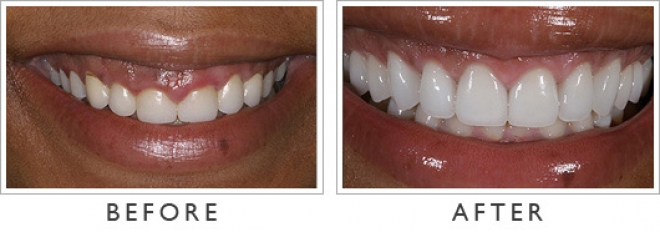Dental veneers (sometimes known as porcelain veneers or dental porcelain laminates) are wafer-thin, custom-made shells of tooth-colored materials made with the purpose of covering the front surface of an individual’s teeth in order to improve one’s appearance. The veneers are bonded to the front of the teeth, changing their shape, color, length, or size.
Dental veneers can either be made from porcelain or from resin composite materials. Porcelain veneers guard against stains better than resin veneers and do a better job of mimicking the light reflective properties of an individual’s natural teeth. Resin veneers are typically thinner and require the removal of less of the tooth surface before being placed on said tooth. You will want to discuss the different options for veneer materials with your doctor before the procedure.
Which problems do dental veneers typically resolve?
Veneers are typically used to fix the following issues:
- Discolored teeth — either due to root canal treatment; stains from tetracycline or other drugs, inordinate amounts of fluoride or other causes; or the presence of large resin fillings that have caused discoloration of the tooth
- Teeth that have been worn down
- Teeth that have gaps between them (in order to close existing spaces between these teeth)
- Teeth that have been broken or chipped
- Teeth that have become uneven, misaligned, or irregularly shaped (for example, having bulges or craters in them)
What’s the Procedure for Getting a Dental Veneer?
Getting a dental veneer usually warrants 3 trips to the patient’s dentist – one for a consultation and an additional two in order to make and apply the veneers. One tooth or many teeth can concurrently undergo the veneering procedure that we have described below.
- Planning the diagnosis and treatment. This first step requires the patient’s active participation. Explanation to the dentist of the types of results that they are attempting to realize. During this appointment, the dentist will likely examine the patient’s teeth in order to make certain that dental veneers are the appropriate course of action and discussion of what the procedure will involve, as well as some of the limitations. The dentist may also take some X-rays and possibly take impressions of the patient’s mouth and teeth.
- Preparation. To prepare a tooth for a veneer, the dentist will remove roughly 0.5 millimeters of the tooth’s enamel from the surface of the tooth, which is an amount approximately equal to the thickness of the veneer that will be added to the patient’s tooth surface. Before shaving off the enamel, the patient and the dentist will decide upon the need for local anesthesia in order to numb that area. Next, the dentist will create a model or take an impression of the tooth. This model is then sent to a dental laboratory, which will in turn construct the veneer. This process typically takes one or two weeks before the dentist receives the veneers back from the laboratory. For very unhealthy teeth, temporary dental veneers may be placed (typically at additional cost).
- Bonding. Before the new dental veneer is permanently affixed to the tooth, the dentist will temporarily position it on the tooth in order to examine its color and fit. The dentist will repeatedly remove and shave / shape the veneer as needed in order to get the proper fit; the veneer’s color may be adjusted along with the shade of cement to be used. Next, to prepare the tooth for the placement of the veneer, the tooth will be cleaned up, polished smooth, and then etched — which adds roughness the tooth in order to allow for a stronger bonding process. A special type of cement is applied to the veneer and the veneer is then placed onto the tooth. Once properly positioned on the tooth, the dentist will then apply a special beam of light to the dental veneer which activates certain chemicals in the cement and causes hardening or curing to happen faster. The final steps involve removing (if any) excess cement, evaluating the patient’s bite and then making any other final adjustments in the veneer as may be necessary. The dentist may ask the patient to schedule a follow-up visit within a few weeks to check how the patient’s gums are reacting to the presence of the new veneer, and to once again examine the placement of the veneer.

